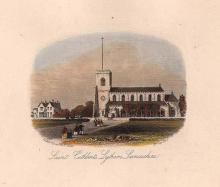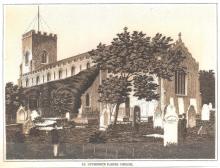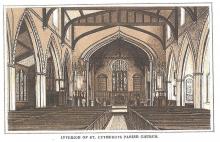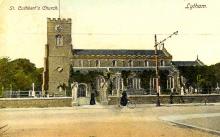There was a church in Lytham in 1199 when Richard Fitz Roger, who is supposed to have belonged to the Banastre family, gave all his lands in Lethum, with the church of the same vill, and all things belonging to the church, to God, and the monks of Durham, that they might establish a Benedictine cell there to the honour of St Mary and St Cuthbert. It is thought that the site of the Benedictine cell, is the site now occupied by Lytham hall.
The grandfather of Richard Fitz Roger pulled down the original church which was made of shingle, and replaced it with another of stone dedicated to St Cuthbert. This building lasted until 1770 when it was replaced by a low building, constructed of cobble stones, the walls being more than a yard thick and penetrated by five windows, one of which was at the east end. Sixty four years from the date of its erection, this church was also pulled down, having been unable to accommodate the increasing influx of visitors during the summer. The foundation stone of the current church was laid by Thomas Clifton on the 20 March 1834. This building cost £1,600.
The parish church of St. Cuthbert, entirely rebuilt in 1834, on the site of the old church, is a building of red brick in the late perpendicular style, consisting of a chancel, clerestoried nave, aisles, south porch and an embattled tower at the west end containing 8 bells : an organ was erected in 1881 at a cost of £700 : the reredos of oak, beautifully carved, is a memorial to Lydia Constance Hawkins, and the stained east window a memorial to Ellen Fisher, who died in 1837 : the north and south chancel windows were given by Thomas Clifton and his wife Lady Eleanor Cecily Clifton : and one in the north aisle Mrs. Anne Wilson in 1878; and there are several others : there is a brass erected by the parishioners to Richard Barton Robinson, late vicar, d. 1875, and another to Edward and Sarah Jane Houghton : the church was re-seated with open oak benches in 1887 at a cost of £1,500 and affords 1,020 sittings, of which 300 are free. The register dates from 1660 and is in good condition : the parish records contain an entry of a collection made for the rebuilding of St. Paul's Cathedral, which realised £1 5s. The living is a vicarage, gross yearly value £340, in the gift of John Talbot Clifton esq. and held since 1870 by the Rev. Henry Beauchamp Hawkins M.A. of Trinity College, Cambridge. hon. canon of Manchester, and surrogate.
from Kelly's Lancashire Directory, 1895
Church of St Cuthbert, Grade II*
The position of the church, set slightly higher than the road and looking south over the Ribble estuary, gives the church a particularly pleasant setting. It was built in the Perpendicular style, in red brick with sandstone dressings and a slate roof. Erected in 1834, it was the third church to be built with that name in Lytham. The design was by Henry Hobden of Warrington and it initially cost £600. It was consecrated by the Bishop of Chester on 27th November 1834. The opening was marked by a procession from the Clifton Arms Hotel to the new church, led by the United Friendly Society and included bands, church wardens, clergy and local inhabitants.
A new organ was installed in 1837 and new stained glass windows in 1845. Further windows were later commissioned and installed, though the changes were not always appreciated by all the congregation, as letters of the time point out. The interior is now noted for its exceptionally fine stained glass windows by well-known makers, including Hardman, Morris and Burne-Jones. A rapidly rising population during the second half of the 19th century led to the enlargement of the church in 1872, at a cost of £1,400. The churchyard was extended that same year. Further improvements took place in 1888, and a north aisle was added in 1909.
Although there is no documentary evidence that the body of St Cuthbert was brought to Lytham as it was taken round the north of England in the face of Viking invasions, the association of the saint with Lytham has long been commemorated by St Cuthbert’s Cross in Church Road. The present cross was dedicated by the Archdeacon of Lancaster, Rev. Phipps Hornby, on 8th December 1912, after the then Vicar of St Cuthbert’s, Canon Hawkins, had it restored as a thank-offering for his recovery from illness.
Sandstone pedestal sundial, St Cuthbert’s churchyard
Three metres south-east of the porch of St. Cuthbert’s Church is a sandstone pedestal sundial with a copper gnomon (rod). Unfortunately the inscription is illegible.
‘Laura Janet’ monument, St Cuthbert’s churchyard
In the graveyard approximately 30 metres to the north of church is the monument which commemorates the seven Lytham members of the St Annes lifeboat Laura Janet who died while attempting to rescue the crew of the German barque Mexico during a storm on the 9th December 1886. It is in red sandstone in Gothic style. The arch on the east side contains a carving depicting the crew rowing through heavy seas, below which is a memorial inscription.
from "The listed buildings of Lytham St. Annes" - Lytham St. Annes Civic Society 2003
If you have additional information or pictures that may usefully added to this page then please get in touch with us.



